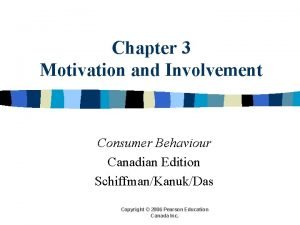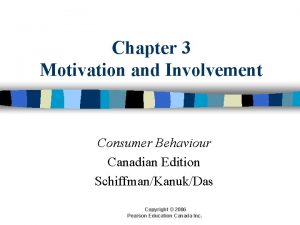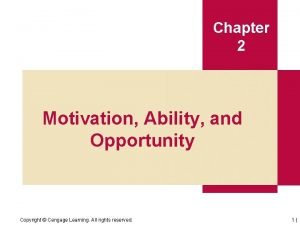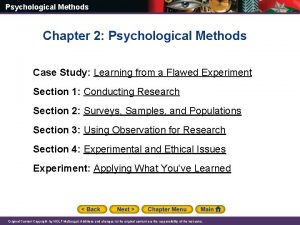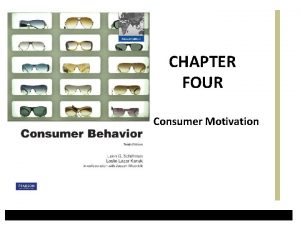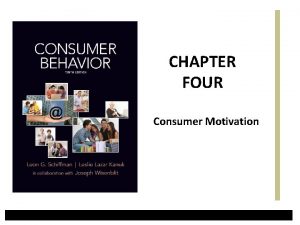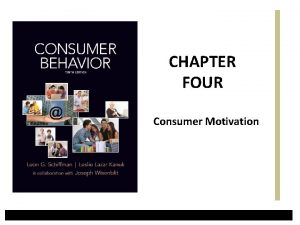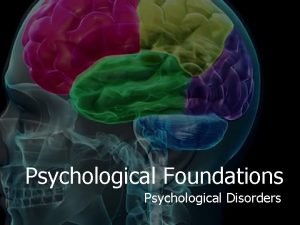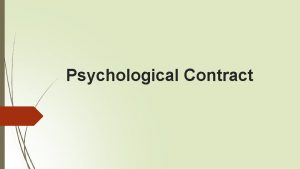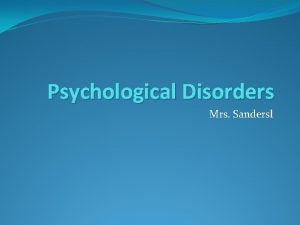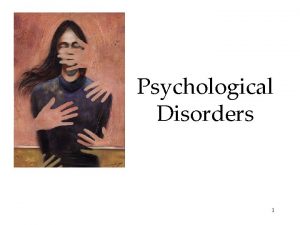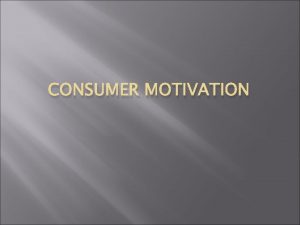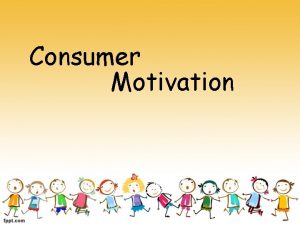Chapter Four CONSUMER MOTIVATION MOTIVATION AS A PSYCHOLOGICAL















- Slides: 15

Chapter Four CONSUMER MOTIVATION

MOTIVATION AS A PSYCHOLOGICAL FORCE Motivation is the driving force within individuals that impels them to action. This driving force is produced by a state of tension, which exists as the result of an unfulfilled need. Individuals strive both consciously and subconsciously to reduce this tension through behavior that they anticipate will fulfill their needs and thus relieve them of the stress they feel. The specific goals they select and the patterns of action they undertake to achieve their goals are the results of individual thinking and learning. Needs: Every individual has needs: some are innate, others are acquired. Innate needs are physiological (i. e. , biogenic); they include the needs for food, water, air, clothing, shelter, and sex. Because they are needed to sustain biological life, the biogenic needs are considered primary needs or motives. Acquired needs are needs that we learn in response to our culture or environment. These may include needs for self-esteem, prestige, affection, power, and learning. Because acquired needs are generally psychological (i. e. , psychogenic), they are considered secondary needs or motives.

MODEL OF THE MOTIVATION PROCESS Previous Learning Unfulfilled Needs, Wants, and Desires Tension Drive Behavior Cognitive Processes Tension Reduction Goal or Need Fulfillment

MOTIVATION AS A PSYCHOLOGICAL FORCE/Cont. . Goals: Goals are the sought-after results of motivated behavior. As motivation Process indicated, all behavior is goal oriented. Our discussion of motivation in this chapter is in part concerned with generic goals, that is, the general classes or categories of goals that consumers see as a means to fulfill their needs. If a student tells his parents that he wants to become a medical doctor, he has stated a generic goal. If he says he wants to get an M. D. degree from UCLA, he has expressed a product-specific goal. Marketers are particularly concerned with product-specific goals, that is, the specifically branded products and services that consumers select for goal fulfillment.

THE NEEDS AND GOALS BEHIND LOSING OR MAINTAINING BODY WEIGHT Feedback reactions "How do I feel about achieving/not achieving my goal? " Goal setting "What are the goals I can pursue, and why do I want to pursue them? Formation of a goal intention "What is it for which I strive? Action planning "How can I achieve my goal? " ("When, where, how, and how long should I act? ") Action initiation and control "How well have I enacted my plans? " "Am I making progress toward my goal? " "Are there adjustments that need to be made? " "Is the goal still important to me? " Goal attainment/ failure "To what degree have I achieved/ failed to achieve my goal? "

THE NEEDS AND GOALS BEHIND LOSING OR MAINTAINING BODY WEIGHT/Cont… General Representation of Goal Hierarchy Super-ordinate goals Example of Goal Hierarchy (abbreviated) "Why do I want to achieve that for which I strive? " Live longer Look and feel good Boost self confidence Focal goal Subordinate goals "What is it for which I strive? " "How can I achieve that for which I strive? " Goal: Lose weight Exercising Dieting

POSITIVE AND NEGATIVE MOTIVATION Motivation can be positive or negative in direction. We may feel a driving force toward some object or condition or a driving force away from some object or condition. for example, a person may be impelled toward a restaurant to fulfill a hunger need, and away from motorcycle transportation to fulfill a safety need. Some psychologists refer to positive drives as needs, wants, or desires and to negative drives as fears or aversions. However, although positive and negative motivational forces seem to differ dramatically in terms of physical (and sometimes emotional) activity, they are basically similar in that both serve to initiate and sustain human behavior. For this reason, researchers often refer to both kinds of drives or motives as needs, wants and desires. Some theorists distinguish wants from needs by defining wants as product-specific needs. Others differentiate between desires, on the one hand, and needs and wants on the other. Thus, there is no uniformly accepted distinction among the terms needs, wants, and desires. RATIONAL VERSUS EMOTIONAL MOTIVES Some consumer behaviorists distinguish between so-called rational motives and emotional motives. They use the term rationality in the traditional economic sense, which assumes that consumers behave rationally by carefully considering all alternatives and choosing these that give them the greatest utility. In a marketing context, the term rationality implies that consumers select goals based on totally objective criteria, such as size, weight, price, or miles per gallon. Emotional motives imply the selection of goals according to personal or subjective criteria (e. g. , pride, fear, affection, or status).

THE DYNAMICS OF MOTIVATION Needs are never fully satisfied: Most human needs are never fully or permanently satisfied. For example, at fairly regular intervals throughout each day individuals experience hunger needs that must be satisfied. Most people regularly seek companionship and approval from others to satisfy their social needs. Even more complex psychological needs are rarely fully satisfied. New needs emerge as old needs are satisfied: Some motivational theorists believe that a hierarchy of needs exists and that new, higher-order needs emerge as lower-order needs are fulfilled. For example, a man whose basic physiological needs (e. g. , food, housing, etc. ) are fairly well satisfied may turn his efforts to achieving acceptance among his neighbors by joining their political clubs and supporting their candidates. Success and failure influence goals: A number of researchers have explored the nature of the goals that individuals set for themselves. Broadly speaking, they have concluded that individuals who successfully achieve their goals usually set new and higher goals for themselves; that is, they raise their levels of aspiration. This may be due to the fact that their success in reaching lower goals makes them more confident of their ability to reach higher goals. Conversely, those who do not reach their goals sometimes lower their levels of aspiration. Thus, goal selection is often a function of success and failure.

THE DYNAMICS OF MOTIVATION/Cont…. DEFENSE MECHANISM DESCRIPTION AND ILLUSTRATIONS Aggression In response to frustration, individuals may resort to aggressive behavior in attempting to protect their self-esteem. The tennis pro who slams his tennis racket to the ground when disappointed with his game or the baseball player who physically intimidates an empire for his call are examples or such conduct. So are consumer boycotts or companies or stores. Rationalization People sometimes resolve frustration by inventing plausible reasons for being unable to attain their goals (e. g. , how important is it to achieve a high bowling score? ) Regression An individual may react to a frustrating situation with childish or immature behavior. A shopper attending a bargain sale, for example, may fight over merchandise and even rip a garment that another shopper will not relinquish rather than allow the other person to have it. Withdrawal Frustration may be resolved by simply withdrawing from the situation. For instance, a person who has difficulty achieving officer status in an organization may decide he can use his time more constructively in other activities and simply quit that organization. Projection An individual may redefine a frustrating situation by projecting blame for his or her own failures and inabilities on other objects or persons. Thus, the golfer who misses a stroke may blame his golf clubs or his caddy.

THE DYNAMICS OF MOTIVATION/Cont…. DEFENSE MECHANISM DESCRIPTION AND ILLUSTRATIONS Daydreaming Day dreaming, or fantasizing, enables the individual to attain imaginary gratification of unfulfilled needs. A person who is shy and lonely, for example, may daydream about a romantic love affair. Identification People resolve feelings of frustration by subconsciously identifying with other persons or situations that they consider relevant. For example, slice-of-life commercials often portray a stereotypical situation in which an individual experiences a frustration and then overcomes the problem by using the advertised product. If the viewer can identify with the frustrating situation, he or she may very likely adopt the proposed solution and buy the product advertised. Repression Another way that individuals avoid the tension arising from frustration is by repressing the unsatisfied need. Thus, individuals may "force" the need out of their conscious awareness. Sometimes repressed needs manifest themselves indirectly. The wife who is unable to bear children may teach school or work in a library; her husband may do volunteer work in a boys' club. The manifestation of repressed needs in a socially acceptable form is called sublimation, another type of defense mechanism.

TYPES AND SYSTEMS OF NEEDS Hierarchy of needs MURRAY'S LIST OF PSYCHOGENIC NEEDS ASSOCIATED WITH INANIMATE OBJECTS • Acquisition • Conservancy • Order • Retention • Construction NEEDS THAT REFLECT AMBITION, POWER, ACCOMPLISHMENT, AND PRESTIGE • Superiority • Achievement • Recognition • Exhibition • Inviolacy (inviolate attitude) • Infavoidance (to avoid shame, failure, humiliation, ridicule) • Defendance (defensive attitude) • Counteraction (counteractive attitude)

TYPES AND SYSTEMS OF NEEDS Hierarchy of needs MURRAY'S LIST OF PSYCHOGENIC NEEDS CONCERNED WITH HUMAN POWER • Dominance • Deference • Similance (suggestible attitude) • Autonomy • Contrariance (to act differently from others) SADOMASOCHISTIC NEEDS • Aggression • Abasement NEEDS CONCERNED WITH AFFECTION BETWEEN PEOPLE • Affiliation • Rejection • Nurturance (to nourish, aid, or protect the helpless) • Succorance (to seek aid, protection, or sympathy) • Play NEEDS CONCERNED WITH SOCIAL INTERCOURSE (THE NEEDS TO ASK AND TELL) • Cognizance (inquiring attitude) • Exposition (expositive attitude)

TYPES AND SYSTEMS OF NEEDS Hierarchy of needs MASLOW'S HIERARCHY OF NEEDS Self-Actualization (Self-fulfillment) Ego Needs (Prestige, status, self-esteem) Social Needs (Affection, friendship, belonging) Safety and Security Needs (Protection, order, stability) Physiological Needs (Food, water, air, shelter, sex)

A TRIO OF NEEDS Power: The power need relates to an individual's desire to control his or her environment. It includes the need to control other persons and various objects. This need appears to be closely related to the ego need, in that many individuals experience increased self-esteem when they exercise power over objects or people. Affiliation: Affiliation is a well-known and well-researched social motive that has far-reaching influence on consumer behavior. The affiliation need suggests that behavior is strongly influenced by the desire for friendship, for acceptance, for belonging. People with high affiliation needs tend to be socially dependent on others. They often select goods they feel will meet with the approval of friends. Teenagers who hang out at malls or techies who congregate at computer shows often do so more for the satisfaction of being with others than for making a purchase. Achievement: A considerable number of research studies have focused on the achievement need. Individuals with a strong need for achievement often regard personal accomplishment as an end in itself. The achievement need is closely related to both the egoistic need and the self-actualization need. People with a high need for achievement tend to be more self-confident, enjoy taking calculated risks, actively research their environments, and value feedback.

THE MEASUREMENT OF MOTIVES Respondents are asked to indicate their level of agreement or disagreement (i. e. , using a Likert scale) on the following five items: 1. 2. 3. 4. 5. I would buy a product just because it has status. I am interested in new products with status. I would pay more for a product if it had status. The status of the product is irrelevant to me. A product is more valuable to me if it has some snob appeal.
 Primary secondary tertiary consumers
Primary secondary tertiary consumers Primary consumer
Primary consumer Cengage
Cengage Consumer research process
Consumer research process Characteristic of consumer behaviour
Characteristic of consumer behaviour Types of buyer behavior
Types of buyer behavior Four components of psychological health
Four components of psychological health Examples of generic goals and product-specific goals
Examples of generic goals and product-specific goals Dynamics of motivation in consumer behaviour
Dynamics of motivation in consumer behaviour Dynamic nature of motivation in consumer behaviour
Dynamic nature of motivation in consumer behaviour Motivation, ability, and opportunity consumer behaviour
Motivation, ability, and opportunity consumer behaviour Product classifications
Product classifications Chapter 18 psychological disorders
Chapter 18 psychological disorders Chapter 18 psychological disorders
Chapter 18 psychological disorders Chapter 14 psychological disorders
Chapter 14 psychological disorders Single blind study
Single blind study








